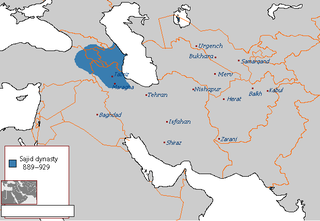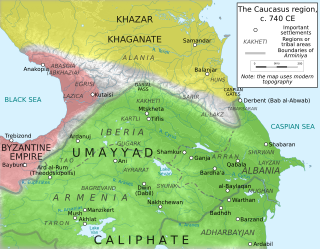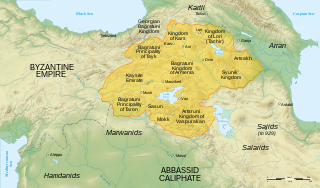
Smbat I, sometimes Smbat A Martyr was the second king of the medieval Kingdom of Armenia of the Bagratuni dynasty, and son of Ashot I. He is the father of Ashot II and Abas I.

Ashot II the Iron was king of the Bagratid kingdom of Armenia from 914 to 929. He was the son and successor of King Smbat I. His reign was filled with rebellions by vassals and pretenders to the throne, as well as foreign invasions, which Ashot fought off successfully, for which he is remembered by the epithet Yerkat’ (Երկաթ), or the Iron.

The Sajid dynasty was an Iranian Muslim dynasty that ruled from 889/890 until 929. The Sajids ruled Azerbaijan and parts of Armenia first from Maragha and Barda and then from Ardabil. The Sajids originated from the Central Asian province of Ushrusana and were of Iranian (Sogdian) descent. Muhammad ibn Abi'l-Saj Diwdad the son of Diwdad, the first Sajid ruler of Azerbaijan, was appointed as its ruler in 889 or 890. Muhammad's father Abu'l-Saj Devdad had fought under the Ushrusanan prince Afshin Khaydar during the latter's final campaign against the rebel Babak Khorramdin in Azerbaijan, and later served the caliphs. Toward the end of the tenth century, as the central authority of the Abbasid Caliphate weakened, Muhammad was able to form a virtually independent state. Much of the Sajids' energies were spent in attempting to take control of neighboring Armenia. The dynasty ended with the death of Abu'l-Musafir al-Fath in 929.
Muhammad ibn Abi'l-Saj also known as Muhammad al-Afshin, an Iranian appointed general of al-Mu'tadid, He was the founder of Sajid dynasty and governor of Azerbaijan, from 889 or 890 until his death. He was the son of Abi'l-Saj Devdad.
Abū'l-Ḥasan Mu'nis al-Qushuri, also commonly known by the surnames al-Muẓaffar and al-Khadim, was the commander-in-chief of the Abbasid army from 908 to his death in 933 CE, and virtual dictator and king-maker of the Caliphate from 928 on.
Abu'l-Sāj Dēvdād was a Sogdian prince, who was of the most prominent emirs, commanders and officials of the Abbasid Caliphate. He was the eponymous ancestor of the Sajid dynasty of Azerbaijan. His father was named Devdasht.

Arminiya, also known as the Ostikanate of Arminiya or the Emirate of Armenia, was a political and geographic designation given by the Muslim Arabs to the lands of Greater Armenia, Caucasian Iberia, and Caucasian Albania, following their conquest of these regions in the 7th century. Though the caliphs initially permitted an Armenian prince to represent the province of Arminiya in exchange for tribute and the Armenians' loyalty during times of war, Caliph Abd al-Malik ibn Marwan introduced direct Arab rule of the region, headed by an ostikan with his capital in Dvin. According to the historian Stephen H. Rapp in the third edition of the Encyclopaedia of Islam:
Early Arabs followed Sāsānian, Parthian Arsacid, and ultimately Achaemenid practice by organising most of southern Caucasia into a large regional zone called Armīniya.
Ashot IV Bagratuni, better known as Ashot Msaker, reputedly for his refusal to refrain from eating meat during Lent, was an Armenian prince from the Bagratid family. A fugitive from the failed uprising in 775 against Arab rule in Armenia, where his father was killed, over the next decades he gradually expanded his domains and established a predominant role for himself in the country's affairs, becoming recognized by the Abbasid Caliphate as presiding prince of Armenia from 806 until his death in 826.

Bagratid Armenia was an independent Armenian state established by Ashot I of the Bagratuni dynasty in the early 880s following nearly two centuries of foreign domination of Greater Armenia under Arab Umayyad and Abbasid rule. With each of the two contemporary powers in the region—the Abbasids and Byzantines—too preoccupied to concentrate their forces on subjugating the region, and with the dissipation of several of the Armenian nakharar noble families, Ashot succeeded in asserting himself as the leading figure of a movement to dislodge the Arabs from Armenia.
Adarnase IV was a member of the Georgian Bagratid dynasty of Tao-Klarjeti and prince of Iberia, responsible for the restoration of the Iberian kingship, which had been in abeyance since it had been abolished by Sasanian Empire in the 6th century, in 888.

Gobron also known as Mikel-Gobron or Michael-Gobron (მიქელ-გობრონი) was a Christian Georgian military commander who led the defense of the fortress of Q'ueli against the Sajid emir of Azerbaijan. When the fortress fell after a 28-day-long siege, Gobron was captured and beheaded, having rejected inducements to convert to Islam. Shortly after his death Gobron became the subject of the hagiography authored by Bishop Stephen of T'beti and a saint of the Georgian Orthodox Church, which commemorates him on November 17. His martyrdom is also mentioned by the medieval Georgian and Armenian chronicles.

Gagik I Artsruni was an Armenian noble of the Artsruni dynasty who ruled over Vaspurakan in southern Armenia, first as prince of northwestern Vaspurakan and after that until his death as King of Vaspurakan, also claiming the title of King of Armenia.
Constantine III was King of Abkhazia from c. 894 to 923 AD. He was the son and successor of Bagrat I of the Anchabadze dynasty.
Ahmad ibn Isa al-Shaybani, was an Arab leader of the Shayban tribe. In 882/3 he succeeded his father, Isa ibn al-Shaykh, as the virtually independent ruler of Diyar Bakr, and soon expanded his control over parts of southern Armenia as well. He gained control over Mosul as well in 891/2, but faced with a resurgent Abbasid Caliphate, he was deprived of the city and forced into a position of vassalage by Caliph al-Mu'tamid. Shortly after his death in 898, the Caliph deprived his son and heir, Muhammad, of the last territories remaining under the family's control.
Bagrat II Bagratuni was an Armenian noble of the Bagratid (Bagratuni) family and the presiding prince of Arab-ruled Armenia between 830 and 851. He succeeded his father, Ashot IV Bagratuni, as ruler of Taron in 826, and was named presiding prince by the Abbasid Caliph in 830. In 849 he began an open rebellion against Abbasid authority in Armenia. The rebellion provoked the dispatch of Bugha al-Kabir to the country, who crushed the revolt in a three-year campaign. Bagrat was treacherously captured during negotiations in 851 and brought captive to the Abbasid capital Samarra. He was succeeded in Taron by his sons, while the title of presiding prince passed to his nephew, the future King Ashot I of Armenia.

Abu'l-Hasan Ali ibn Muhammad ibn Musa ibn al-Hasan ibn al-Furat was a senior official of the Abbasid Caliphate who served three times as vizier under Caliph al-Muqtadir. Ali emerged into prominence as an able fiscal administrator and deputy to his older brother Ahmad. Eventually he came to lead one of the two major and rival court factions during al-Muqtadir's caliphate, the Banu'l-Furat, the other being the group of officials around the commander-in-chief Mu'nis al-Muzaffar and the vizier Ali ibn Isa al-Jarrah.
Muflih al-Saji was a Muslim commander and governor of Adharbayjan from c. 929 to c. 935.
In the history of Azerbaijan, the Early Middle Ages lasted from the 3rd to the 11th century. This period in the territories of today's Azerbaijan Republic began with the incorporation of these territories into the Sasanian Persian Empire in the 3rd century AD. Feudalism took shape in Azerbaijan in the Early Middle Ages. The territories of Caucasian Albania became an arena of wars between the Byzantine Empire and the Sassanid Empire. After the Sassanid Empire was felled by the Arab Caliphate, Albania also weakened and was overthrown in 705 AD by the Abbasid Caliphate under the name of Arran. As the control of the Arab Caliphate over the Caucasus region weakened, independent states began to emerge in the territory of Azerbaijan.
Hamid ibn al-Abbas was an Abbasid magnate who served as vizier of Caliph al-Muqtadir in 918–923. For most of that period, real power lay in the hands of his deputy, Ali ibn Isa ibn al-Jarrah, while Hamid tended to his tax farming estates at Wasit.
The Qarmatian invasion of Iraq was a large-scale raid by the Qarmatians of Bahrayn against the Abbasid Caliphate's metropolitan region of Iraq, that began in autumn of 927 and continued until the summer of 928.









